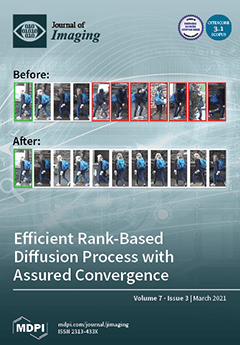Background: Micro-positron emission tomography (micro-PET), a small-animal dedicated PET system, is used in biomedical studies and has the quantitative imaging capabilities of radiotracers. A single-bed system, commonly used in micro-PET, is laborious to use in large-scale studies. Here, we evaluated the image
[...] Read more.
Background: Micro-positron emission tomography (micro-PET), a small-animal dedicated PET system, is used in biomedical studies and has the quantitative imaging capabilities of radiotracers. A single-bed system, commonly used in micro-PET, is laborious to use in large-scale studies. Here, we evaluated the image qualities of a multi-bed system.
Methods: Phantom imaging studies were performed to assess the recovery coefficients (RCs), uniformity, and spill-over ratios (SORs) in water- and air-filled chambers.
18F-FDG and
18F-FPEB PET images of xenograft and normal mice from the multi-bed and single-bed systems were compared.
Results: For small diameters (< 3 mm), the RC values between the two systems differed significantly. However, for large diameters (> 4 mm), there were no differences in RC values between the two systems. Uniformity and SORs of both systems were within the tolerance limit of 15%. In the oncological study, the estimation of
18F-FDG uptake in the tumor was significantly lower in the multi-bed system than that in the single-bed system. However,
18F-FDG PET in xenograft mice with tumor size > 4 mm revealed the variation between subjects within the multi-bed system group to be less than 12%. In the neurological study, SUV for the multi-bed group was 25–26% lower than that for the single-bed group; however, inter-object variations within the multi-bed system were below 7%.
Conclusions: Although the multi-bed system showed lower estimation of radiotracer uptake than that of the single-bed system, the inter-subject variations were within acceptable limits. Our results indicate that the multi-bed system can be used in oncological and neurological studies.
Full article






